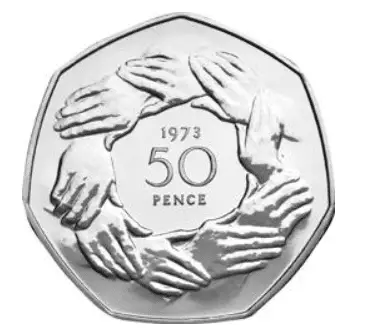The 1973 EEC 50p coin was the first commemorative 50p coin to be released into circulation in the UK. This means that it is an old-style 50p with a larger diameter, and not currently in circulation today – but how much is it worth now?
From our research, the EEC 50p sells for an average of £1.86 on eBay in circulated condition without postage and packaging.
Let’s dive into the specifications of the coin, including its mintage and design, to see what makes it worth three times over face value to collectors.
1973 European Economic Community 50p Mintage
The 1973 EEC 50p had a mintage of 89,775,000 and, as previously mentioned, was the first commemorative 50p design to ever be released into circulation.
This mintage is the highest of any commemorative 50p design, which means that the coin is not rare at all. The collectable value comes from the history of the coin and when it was minted, rather than the number of coins that were made.
To put this into perspective, the lowest mintage of an old-style commemorative 50p is 109,000 for the 1992 Single Market 50p which coincidently also pays tribute to the European Union.
Other uncirculated versions of the coin were also released for collectors and they can be seen below:
- There were also commemorative coins issued in the 1973 EEC Entry and 2020 Withdrawal from the European Union UK 50p Two-Coin Set.
- Additionally, there were Proof coins issued in The Coinage of Great Britain & Northern Ireland 1973 set that included 6 coins including the Fifty Pence EEC.
- There was also an unknown amount of Silver Proof Piedfort FDC coins issued.
- In addition to the coins released into circulation as the 1973 EEC 50p, there were also two other 50p coins released to mark Britain joining the EU. One was released in 1998, and the other in the early 90s.
1973 EEC 50p coin Design
Obverse
The Obverse features the Queen’s portrait by Arnold Machin. She wears the “Girls of Great Britain and Ireland” Tiara. The Tiara was a wedding gift from Queen Mary in 1947. Queen Mary was Her Majesty’s grandmother. This is the same Tiara she is wearing in the Ian Rank-Broadley portrait. This image was used until 1984.
She is facing right, crowned and draped as a young bust. This image is sometimes referred to as the Second Portrait. Around her is the monarch’s legend: ELIZABETH II D G REG F D, which is Latin meaning Elizabeth the Second, by the Grace of God, Queen, Defender of the Faith.
ELIZABETH II is curved along the outer rim on her right. The rest of the legend is curved on the left-hand side of her portrait along the outer rim.
Reverse
The reverse of the EEC 50p shows a ring of 9 hands joined together.
This represents the 9 countries that were part of the European Community in 1973 after Denmark, Ireland and the United Kingdom joned.

The design was the creation of David Wynee, a sculptor whose work we will take a look at later in the article.
This design is also known as the ’50p with hands’ and the ‘ring of hands 50p’ due to the iconic design.
David Wynne Coin Designer
David Wynne was a British sculptor who focused on animals, figures, and portraits. One of his famous sculptures is one he did of The Beatles in 1964. He also introduced the Fab Four to the Maharishi Mahesh Yogi who influenced a lot of the band’s songs and philosophic thinking. Wynne also did a sculpture of the Maharishi Mahesh Yogi.
Wynne received the Most Excellent Order of the British Empire OBE award in 1994.
The EEC 50p coin design was the only reverse side of a coin he created. He had originally considered using a ring of 10 hands as opposed to the final design including 9 hands.
From the time he began crafting his design to the official minting of the coin, the expected number of members was reduced from ten to nine with the withdrawal of Norway.
He used models of hands of his own, his wife, and one of his sons. He also used a craftsman who assisted in his studio and the hands of a girl who helped look after his children.
The hand that was omitted was one of the girl’s hands. But, her other hand remained in the final 9-hand version and seems to stand out as being more delicate. However, he did not intend on any of the individual hands to represent a specific member of the Community.
What does the 1973 EEC 50p coin represent?
On January 1, 1973, Britain officially joined the European Economic Community, EEC. This was a result of a vote that took place months earlier, in July. Parliament voted 301-284 in favour of joining the EEC.
Two years later, Britain decided to ratify its membership in a referendum. The UK voted 67% to 32% to remain in the common market. In 2016, this referendum was reversed with the UK voting 52-48 to leave in what became known as Brexit.
In 1973, joining the EEC was a reason to celebrate. So much so that The Royal Mint issued this special 50p coin to celebrate the UK’s accession to the European Economic Community. After years of debate, Britain finally successfully joined the European Economic Community, EEC, in 1973.
The 9 hands on the coin symbolize the nine members of the Community, clasping one another in a mutual gesture of trust, assistance, and friendship. The members include the UK, Denmark, and Ireland joining the six founding members of the EEC. Ireland and Denmark also joined the EEC in 1973.
Other 50p coins relating to the European Union include the 1992 Single Market 50p, as well as the infamous Brexit 50p.